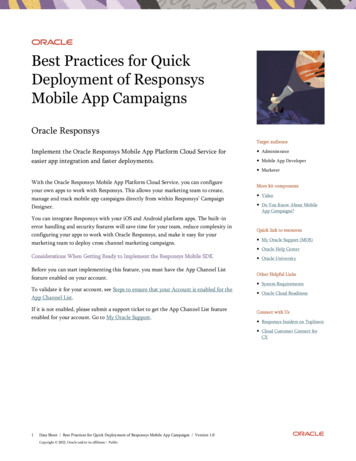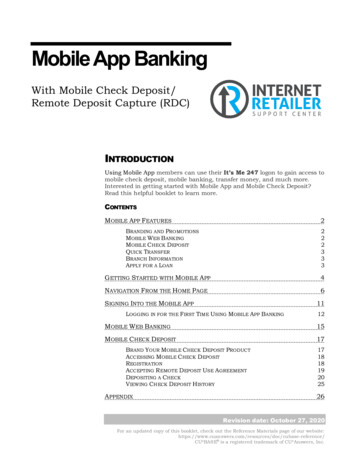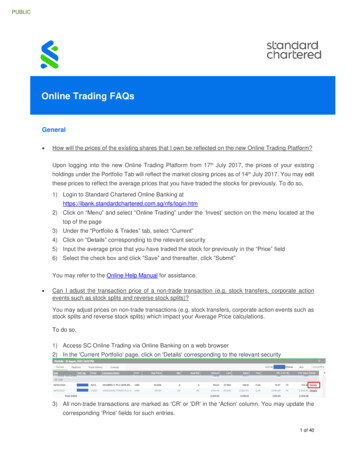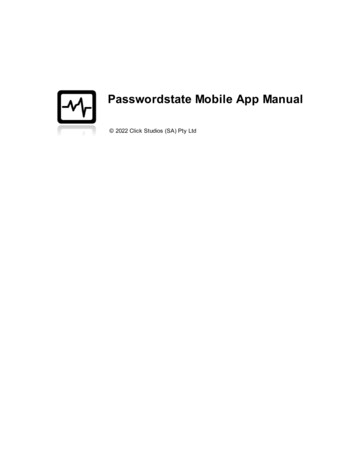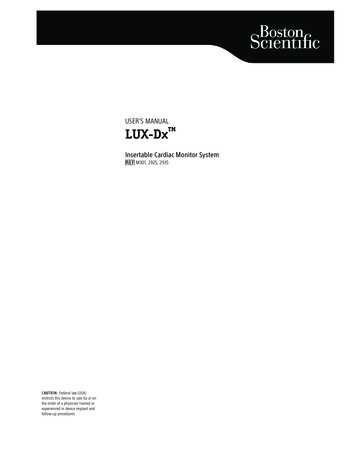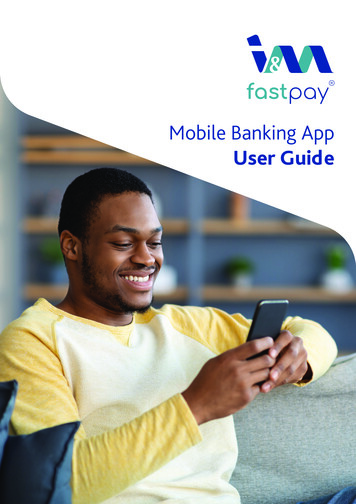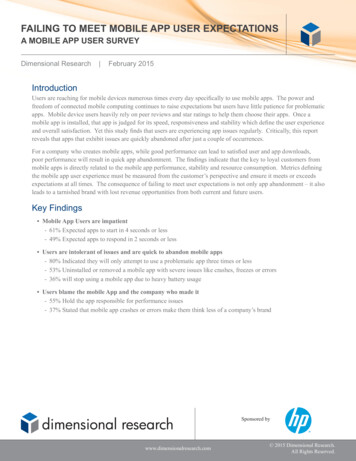
Transcription
FAILING TO MEET MOBILE APP USER EXPECTATIONSA MOBILE APP USER SURVEYDimensional Research February 2015IntroductionUsers are reaching for mobile devices numerous times every day specifically to use mobile apps. The power andfreedom of connected mobile computing continues to raise expectations but users have little patience for problematicapps. Mobile device users heavily rely on peer reviews and star ratings to help them choose their apps. Once amobile app is installed, that app is judged for its speed, responsiveness and stability which define the user experienceand overall satisfaction. Yet this study finds that users are experiencing app issues regularly. Critically, this reportreveals that apps that exhibit issues are quickly abandoned after just a couple of occurrences.For a company who creates mobile apps, while good performance can lead to satisfied user and app downloads,poor performance will result in quick app abandonment. The findings indicate that the key to loyal customers frommobile apps is directly related to the mobile app performance, stability and resource consumption. Metrics definingthe mobile app user experience must be measured from the customer’s perspective and ensure it meets or exceedsexpectations at all times. The consequence of failing to meet user expectations is not only app abandonment – it alsoleads to a tarnished brand with lost revenue opportunities from both current and future users.Key Findings Mobile App Users are impatient-- 61% Expected apps to start in 4 seconds or less-- 49% Expected apps to respond in 2 seconds or less Users are intolerant of issues and are quick to abandon mobile apps-- 80% Indicated they will only attempt to use a problematic app three times or less-- 53% Uninstalled or removed a mobile app with severe issues like crashes, freezes or errors-- 36% will stop using a mobile app due to heavy battery usage Users blame the mobile App and the company who made it-- 55% Hold the app responsible for performance issues-- 37% Stated that mobile app crashes or errors make them think less of a company’s brandSponsored bywww.dimensionalresearch.com 2015 Dimensional Research.All Rights Reserved.
FAILING TO MEET MOBILE APP USER EXPECTATIONSA MOBILE APP USER SURVEYDimensional Research February 2015Detailed FindingsWhile 80% of participants indicated that they reach for a mobile device up to 15 times a day, it was interesting tonote that 18% of users access their device up to 50 times daily. As mobile apps continue to mature and offer moreservices, often with user specific context, the value of mobile apps will continue to rise. We expect the number ofapps used each day to rise in the 40%30%18%20%10%0%2%1–1515–50Morethan50While many products are often chosen by price, in this study we find that price is only the third selection criteria.Users stated that they initially search for mobile apps based on desired functionality, but the actual mobile appchoice is based on peer reviews and star ratings. Users want a 5-star mobile app more than they want the cheapestone. This clearly indicates that functionality and user experience, as defined by stability and performance, directlyinfluence user satisfaction. This forms a product cycle in which apps that deliver a better user experience willgenerate positive peer feedback – thereby driving more pposedtodo)34%Page 2www.dimensionalresearch.com 2015 Dimensional Research.All Rights Reserved.
FAILING TO MEET MOBILE APP USER EXPECTATIONSA MOBILE APP USER SURVEYDimensional Research February 2015Nearly all users (96%) stated that performance is important, while over three quarters (76%) shared that it is veryimportant or critically important. This indicates that users’ satisfaction with an app is directly correlated to theirperception of the app’s performance. App performance is not only based on app load times but responsiveness toselections as well as the speed at which it performs its 0%40%50%60%70%80%90%100%Nearly half (49%) of those participating in the survey indicated they expect a mobile app to perform its actions in twoseconds or less. But only a small number of users (9%) would be willing to wait four or more seconds which redefinesthe range of expected performance. This finding may also signal that long held “3 second rule” is being supersededfor mobile apps. Given the high importance participants placed on app performance, it is critical that developersdesign and ensure the mobile apps they deploy should meet the two second threshold that half the market ond2seconds3seconds4secondsMorethan4secondsTo understand the quality and performance of apps today, participants were asked how often they have issues withmobile apps. 12% of the respondents indicated they have app issues daily, while 17% stated they have app problemsPage 3www.dimensionalresearch.com 2015 Dimensional Research.All Rights Reserved.
FAILING TO MEET MOBILE APP USER EXPECTATIONSA MOBILE APP USER SURVEYDimensional Research February 2015weekly. That means that over a quarter of the market (27%) are having at least one app issue every week. Whileanother 19% stated they have a problem at least once a month. Adding those three segments indicates that nearlyhalf (48%) of the users are having problems at least once a ants were further asked about severe app issues where the mobile app may have crashed, stopped working orreturned an error. Over the last six months over half the users indicated that they had experienced a severe app issue.Having learned the importance of performance and now seeing the high frequency of issues users have with mobileapps, developers need to ask themselves, what are the real world ramifications of users having 7%Yes53%In order to understand where users place responsibility for app performance and issues, we asked them what theythought was the cause of mobile app issues. 55% placed the blame squarely on the mobile app itself, which meansthat regardless of the actual cause, over half of all users will hold the app responsible. Many survey respondentsPage 4www.dimensionalresearch.com 2015 Dimensional Research.All Rights Reserved.
FAILING TO MEET MOBILE APP USER EXPECTATIONSA MOBILE APP USER SURVEYDimensional Research February 2015(39%) indicated that they didn’t know what the cause was. But clearly device, the OS and mobile network sharemuch less of the user blame than the app. This means that those companies offering, managing and developingmobile apps should expect the finger pointed at them more often, regardless of whether the app is really at fault or bletopera et13%Ireallydon’tknow29%0%10%20%30%40%50%60%When asked what they did with a mobile app that performed slowly, three of the top four answers were soberingand indicated that users abandoned the app. 48% fully removed the app from the device, while 33% simply stoppedusing it, and 32% looked for a replacement. 30% didn’t abandon the mobile app but shared they used the app lessoften. However, 37% did take additional action by looking for an app update to remedy the performance er4%Nothing,Is6llusetheapp16%0%Page %45%50% 2015 Dimensional Research.All Rights Reserved.
FAILING TO MEET MOBILE APP USER EXPECTATIONSA MOBILE APP USER SURVEYDimensional Research February 2015Participants responded similarly when asked what actions they took with apps that had severe issues, such ascrashes, stopped responding and produced errors. Most users (53%) removed the app completely, and 37% stoppedusing the app, while 28% looked for an alternative. But the findings are quite clear: companies that produce poorperforming mobile apps or apps with severe issues will not see those apps used for long, resulting in lost customersand revenue s6llusetheapp0%10%20%30%40%50%60%This next question investigates how many chances a problematic app has before a user decides to abandon it.Participant’s responses are striking in that users don’t have a lot of patience for mobile app issues, as 80% of usersindicated that an app will get a maximum of three chances before they stop using it. The result is three strikes andyou are out. Furthermore, more than half (56%) of users will only give an app two chances and 6% will abandon anapp at the first sign of an issue. Companies that offer mobile apps have a very tight window for remedying issuesbefore users %25%20%15%15%10%6%6%8%6%45Morethan55%0%Page com 2015 Dimensional Research.All Rights Reserved.
FAILING TO MEET MOBILE APP USER EXPECTATIONSA MOBILE APP USER SURVEYDimensional Research February 2015While much of the study focused on direct usage and performance of a mobile app, we wanted to understand if theindirect effects of an app upon a mobile device mattered to users. Thus, participants were asked whether an app’simpact on battery and data usage was important to them. Over a third of the users (36%) had actually stopped usinga mobile app because of heavy battery usage and 20% ceased using an app because of the amount of data consumed.Mobile device users know that heavy battery usage means the risk of not having their device available when theyneed it most – forcing them to frequently search for charging options. Data usage for most users has a directmonetary impact given that mobile device plans are defined by data usage with stiff penalties for exceeding planlimits. Thus users are showing that app choice and ongoing satisfaction is also affected by battery and data %10%20%30%40%50%60%Mobile device users were asked if issues with devices negatively reflected on their opinion of the company whomade the app. 37% of the users who experienced a mobile app that crashed or froze thought less of the companythat made the app. Slightly behind, 36% of users who had experienced slow performance issues had a lower opinionof the company. Users also showed that apps that are difficult to use (28%), are costly (25%) and have heavy batteryuse (25%), all contribute to a negative perception of the company. Thus not only will a company lose customerswhen an app has an issue but the company’s brand becomes tarnished as pinionofthecompany31%0%Page % 2015 Dimensional Research.All Rights Reserved.
FAILING TO MEET MOBILE APP USER EXPECTATIONSA MOBILE APP USER SURVEYDimensional Research February 2015SummaryUsers are reaching for mobile apps numerous times each day, providing fertile opportunities for businesses. Themobile apps users initially choose are heavily influenced by peer feedback, but we find the user satisfaction isdirectly linked to performance, reliability and battery life. Apps that have slow performance as defined by a new twosecond standard or exhibit issues such as crashes or errors are abandoned after just two or three incidents. Poor userexperience will not only make its way into peer feedback that results in a diminished number of new users for anapp, but it also negatively affects a company’s brand. Whether a company has mobile apps as their primary businessor as an added value service, they must take performance and stability of the app and other related user experienceseriously. Therefore, it is crucial to understand the user experience, specifically the performance and stability of anapp, but the metrics must be monitored from the user’s perspective.Survey MethodologyMobile device users from an independent database were invited to participate in a web survey on the topic of mobiledevice apps. A total of 3011 respondents across Belgium, Canada, France, Germany, Netherlands, United Kingdom,and United States who used mobile apps completed the survey. The survey was administered electronically andparticipants were offered a token compensation for their participation.Europe,1509Page arch.com 2015 Dimensional Research.All Rights Reserved.
FAILING TO MEET MOBILE APP USER EXPECTATIONSA MOBILE APP USER SURVEYDimensional Research February 2015About Dimensional ResearchDimensional Research provides practical marketing research to help technology companies make their customersmore successful. Our researchers are experts in the people, processes, and technology of corporate IT and understandhow IT organizations operate. We partner with our clients to deliver actionable information that reduces risks,increases customer satisfaction, and grows the business. For more information visit www.dimensionalresearch.com.About HPHP creates a new style for IT and the possibility for technology to have a meaningful impact on people, businesses,governments, and society. The world’s largest technology company, HP brings together a portfolio that spansprinting, personal computing, software, services, and IT infrastructure to solve customer problems. More informationabout HP (NYSE: HPQ) is available at www.hp.com.Page 9www.dimensionalresearch.com 2015 Dimensional Research.All Rights Reserved.
When asked what they did with a mobile app that performed slowly, three of the top four answers were sobering and indicated that users abandoned the app. 48% fully removed the app from the device, while 33% simply stopped using it, and 32% looked for a replacement. 30% didn't abandon the mobile app but shared they used the app less often.
